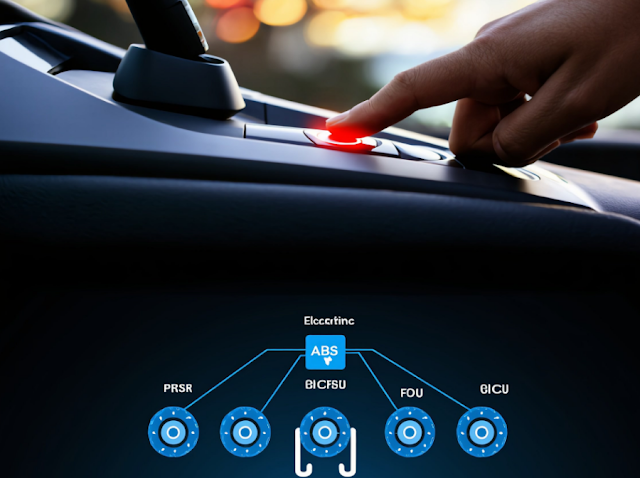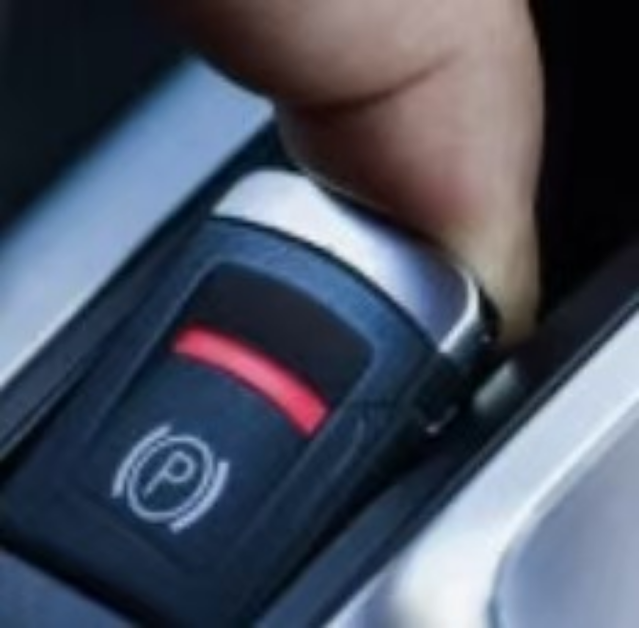I’ll never forget the first car I drove regularly, my dad’s old sedan. It had a classic mechanical handbrake, and I’ve gotta admit, there was something so satisfying about the ziiiiip sound it made when I pulled it up. Fast forward to today, and my new car has this sleek, little button labeled with a “(P)”. It looks clean, modern, and honestly, a little bit mysterious. It got me thinking, and I bet it’s crossed your mind too: What would actually happen if I pulled that thing while cruising down the highway? 🤔
We’ve all seen the movies. The hero is in a high-speed chase, yanks the handbrake, and the car whips around 180 degrees to face the bad guys. It looks awesome, but the thought of that happening accidentally at 70 mph is genuinely terrifying. For the longest time, I treated my Electronic Parking Brake (EPB) button like a self-destruct switch while the car was in motion. But it turns out, the truth is way more interesting and, believe it or not, this button could actually be your last-ditch effort to save your life in an emergency.
The Ghost of Handbrakes Past: Why We’re All Scared 🎬
Let’s first tackle why we have this collective fear. It’s not just you; it’s a completely logical fear rooted in old-school automotive technology. The traditional handbrake, or emergency brake, was a purely mechanical system.
When you pulled that lever, you were physically pulling a steel cable connected directly to the brake calipers or drums on the rear wheels only. It was a simple, direct connection. If you gave that lever a hard yank at high speed, you could easily lock up the rear tires. When your back tires stop spinning but your front ones are still rolling, the back of the car loses traction and tries to swing around the front. That’s what causes that dramatic, and incredibly dangerous, spin.
So, the idea of a car spinning out of control from a misused parking brake isn’t just a Hollywood fantasy; it was a real risk with older cars. But here’s the key: your modern Electronic Parking Brake is a whole different beast. It’s less like a mechanical lever and more like a smart button that talks to your car’s brain.
📋 Quick Summary
The Modern Reality: What Actually Happens When You Pull the EPB 🤯
Alright, so let’s get to the main event. You’re driving, and you pull the EPB switch. What’s the car’s computer thinking? The engineers who designed these systems were smart; they anticipated our clumsy moments and our worst-case scenarios.
The “Oops, I Didn’t Mean To” Moment (A Short Pull)
If you just briefly flick or pull the button by accident, the car is programmed to assume it was a mistake. In almost every modern vehicle, literally nothing will happen other than a beep and a message on your dashboard that says something like, “Parking brake cannot be operated while driving.” Phew. It’s a simple but effective failsafe. The car essentially says, “Hey, are you sure about that?” and ignores the input.
The “My Brakes Are Gone!” Moment (A Continuous Pull)
Now, this is where things get really impressive. If you don’t just flick the button, but you pull it and hold it down, the car’s computer interprets this as a deliberate, desperate act. It thinks, “Okay, this isn’t an accident. The driver is in a serious situation, and the main brakes must have failed.”
💡 How It Works
When you hold the EPB button, the car doesn’t just lock the rear wheels. Instead, it activates a sophisticated emergency braking protocol. This system works hand-in-hand with your car’s main safety features:
- ABS (Anti-lock Braking System): It pulses the brakes on all four wheels to prevent them from locking up and skidding.
- ESC (Electronic Stability Control): It constantly monitors the car’s direction and stability, making tiny adjustments to keep you moving in a straight line.
The result? Your car comes to a very rapid, but incredibly stable and straight stop. It feels like someone is slamming on the brakes for you, but without the swerving or spinning. And yes, your brake lights will turn on to warn the drivers behind you.
Your Last Resort: When and How to Use This Feature ✅
This information is for educational purposes only and should not replace professional advice or the information in your car’s owner’s manual. The emergency EPB function is a last-resort safety feature. Vehicle systems can vary by manufacturer. Always familiarize yourself with your specific vehicle’s features and consult a qualified professional for any safety concerns.
Okay, so we’ve established that this is a powerful tool. But it’s crucial to understand that this is only for a genuine, catastrophic emergency. We’re not talking about a “whoops, I missed my exit” situation. We’re talking about the terrifying moment when you press the brake pedal and… nothing happens.
This could be due to:
- Brake Fade: On a long, steep downhill, your brakes can overheat, and the pedal might feel spongy and go all the way to the floor without much effect.
- Brake Fluid Loss: If a brake line is cut or leaks, you’ll lose hydraulic pressure, and the pedal will offer no resistance. It will just sink to the floor.
Emergency Protocol: Step-by-Step 📝
If you ever find yourself in this nightmare scenario, here’s the game plan:
- Don’t Panic and Hit the Hazards: I know, it’s easy to say. But the first step is to try and stay as calm as possible and immediately turn on your hazard lights to warn other drivers.
- Grip the Wheel Firmly: Keep both hands on the steering wheel and focus on keeping the car pointed straight ahead.
- Pull and HOLD the EPB Switch: This is the most important part. Don’t just tap it. Pull the switch up (or push it, depending on your car) and keep holding it. As long as you are holding it, the car will continue its emergency braking sequence.
- Hold Until You Stop: Keep holding that switch until the car has come to a complete and safe stop. Then, shift into Park.
Never, ever use this as a substitute for your regular brakes. It’s an aggressive, full-force stop designed for emergencies. Using it unnecessarily could surprise drivers behind you and cause unnecessary wear on your braking system. Think of it like the fire extinguisher in your kitchen – you’re glad it’s there, but you hope you never have to use it.
Frequently Asked Questions ❓
So, that little button isn’t just for keeping your car put on a hill. It’s a hidden trump card, a final line of defense engineered for the moment you hope never comes. Just knowing how it works transforms it from a source of anxiety into a source of confidence. You have another tool in your mental toolkit to handle a worst-case scenario on the road.
I hope you never, ever have to use it, but now you know it’s there. What are your thoughts? Did you know about this feature? Feel free to share in the comments below! Stay safe out there. 😊






